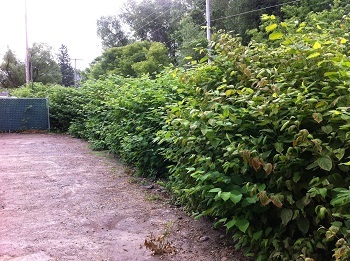|
Dec. 15, 2022
Contact: Joanne Foreman, 517-284-5814

After all the hubbub of the holidays, it can be a relief to get back to your daily routine. Rest assured, the NotMISpecies webinar series will be there, bringing a fresh slate of programs for the new year.

We’ll start by exploring classical biological control with Marianna Szucs from the Department of Entomology at Michigan State University. When infestations of invasive species become too large to control chemically and mechanically, what are the alternatives? If You Can’t Beat ’Em, Find Something That Will Eat ’Em (9 a.m. Wednesday, Jan. 18) looks at her lab’s efforts to establish two host races of the knotweed psyllid (jumping plant lice) that are adapted to control different knotweed species.
|

Though sometimes called “mini lobsters,” invasive red swamp crayfish are anything but cute. Once they show up in an ecosystem, they quickly take over, leaving little or nothing for the locals. We’re checking in with Lucas Nathan, the Department of Natural Resources’ aquatic invasive species coordinator, for Lobster Mobsters: An Update on Michigan’s Red Swamp Crayfish Response (9 a.m. Tuesday, Feb. 7). Join him to hear about recent advances in research and management that are helping to reduce their numbers in southeast Michigan.
|
The hearty crew of staff, partners and volunteers that make up the Michigan Invasive Species Program navigated through some rough waters in 2022, with new detections of beech leaf disease and spotted lanternfly in the state, but they also managed to make a lot of headway. Join Joanne Foreman, the program’s communications coordinator, for Rowing the Boat: The Michigan Invasive Species Program 2022 Year in Review (9 a.m. Tuesday, March 21), an overview of the program’s response efforts, prevention, outreach and survey work to protect Michigan’s natural resources from the effects of invasive species.
How the webinars work
If you haven’t joined us before, make a resolution to start in 2023! Monthly webinars from the Michigan Invasive Species Program provide an inside look at efforts across the state to prevent the introduction and spread of invasive plants, insects, animals and diseases.
Each hourlong session introduces experts with hands-on experience in invasive species research, management and prevention, who provide current information on threats to Michigan’s land and waters. Question and answer sessions and links to resources help attendees get the most out of each presentation.
Watch previous sessions
While the webinar series is on break for the holidays, take some time to catch up on topics you might have missed, including successful phragmites management in the Upper Peninsula, the dos and don’ts of inland lake treatments, and helpful tips for managing invasive species in your backyard.
Recorded versions of all previous webinars are available on the NotMISpecies webpage.
Michigan’s Invasive Species Program, a collaborative effort of the departments of Natural Resources; Environment, Great Lakes, and Energy; and Agriculture and Rural Development, coordinates and supports invasive species initiatives across the state and provides support through the Michigan Invasive Species Grant Program.
/Note to editors: Accompanying photos are available below for download. Suggested captions and photo credit information follow:
Knotweed: Invasive knotweed growing along a fence in Grand Traverse County. Photo courtesy of Northwest Michigan Invasive Species Network.
Crayfish: A red swamp crayfish with eggs captured in a Novi retention pond./
|